Bushbucks do indeed live up to their name, preferring dense bush or forest thickets that provide good cover and make it possible for them to survive even in human-dominated landscapes where there is suitable habitat such as in our suburb on the urban edge.
Although the trees in the exotic eucalyptus and wattle plantations in our area do not provide bushbucks with food directly, the vegetation on the margins provides them with cover and edible plants. Bushbucks are browsers and grazers, eating leaves, young shoots and pods as well as fruits and flowers and they may dig up various tubers and roots and move out from their cover to eat tender young grasses. They are known to follow foraging monkeys and hornbills to benefit from fruits and flowers that are dropped from the trees above. Unfortunately, where they have the opportunity bushbucks are not averse to visiting tasty vegetable gardens.
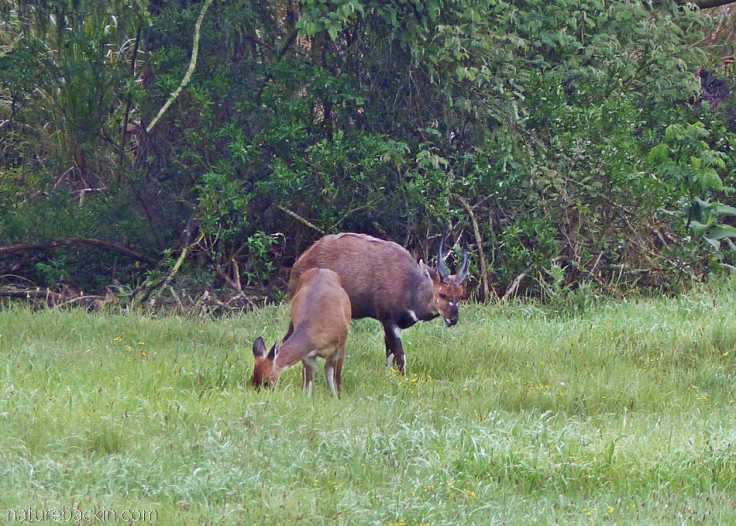
A pair of bushbuck early one misty morning out in the open eating young grasses on a farm in the KwaZulu-Natal midlands on the edge of mistbelt forest
Bushbucks (Tragelaphus sylvaticus) are mostly active in the early mornings, late afternoons and during the night, although they may move around during the day when it is overcast and in places where they feel secure. After venturing out to forage, they return to the dense bush of their home thicket where they spend most of their time resting during the heat the day.

Partially concealed by vegetation, a young bushbuck ram peering at me from the margins of the plantation behind our house, as I peer back at him through the fence
Perhaps more or less typical of how a bushbuck spends its time, in a study in the Queen Elizabeth National Park in Uganda it was found that “day and night ranges were entirely separate. Days were spent in or on the edge of the home thicket, resting 50% (often standing), feeding 38%, and moving 12% of the time. Shortly before dark, each bushbuck moved towards its night range, in open habitat, where it fed 25% of the time. When resting at night in the open, bushbucks usually lay down. All returned to their home thickets before dawn” (Estes p. 139).

Habituated to human visitors, a female bushbuck taking a nap in the shade near the chalets at Cape Vidal camp in the iSimangaliso Wetland Park, KwaZulu-Natal
Bushbucks occur over much of sub-Saharan Africa where suitable habitat remains. Across their range their colouration is variable. In some regions they are darker or redder in colour, with bushbucks in some populations typically having vertical stripes and relatively more white spots on their flanks. Their colouration and markings provide good camouflage. Estes observes that their camouflage serves them well not only when they are standing in a thicket, but also when they are lying down out in the open. He reports that lions and hyenas have been seen passing by bushbucks lying down at night out in the open that were less than 9 metres away (Estes p. 139).
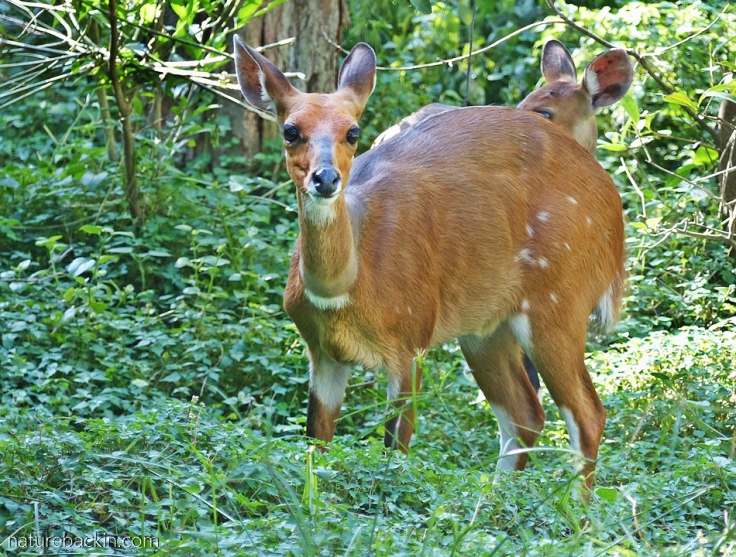
Female bushbucks at Cape Vidal
Adult bushbucks are mostly solitary, pairing up during courtship, although sometimes small female groups with young may occur. Female bushbucks may breed every 6 or 7 months producing one calf. The baby remains concealed for the first 4 months of its life and then remains with the mother until the next baby is born. The mother eats the placenta after the calf is born – presumably so as not to attract predators and also it would provide her with nutrition. When she visits her baby so it may suckle, she cleans up by eating any dung the baby may have dropped before she leaves it concealed on its own while she goes off to forage for food.

A female bushbuck at Cape Vidal
Bushbucks are not territorial and do not defend their range. Although they stay on their own in their home thicket they may feed peacefully in the same clearings as other bushbucks during foraging times. Bushbucks in the same area are likely to be friendly if not exactly sociable acquaintances.

A mature bushbuck ram at Cape Vidal showing his strong sharp horns
In our area we regularly see at least three male bushbuck – they are different sizes, with one being particularly large, and one has a broken horn. The males are larger and darker than the females (height ranges from 0.5 to 1m tall (25-40 inches) at the shoulder. The males carry a set of horns that are almost straight with one spiral near the base. Bushbuck rams are reputed to be pugnacious fighters when cornered or attacked, defending themselves with their sharp horns. Bushbucks emit a surprisingly loud alarm call that resembles the bark of a baboon or dog.

A bushbuck ram crossing a road at Cape Vidal
Bushbuck males are not known for fighting and any dominance hierarchy is maintained largely through ritualised display, with the older males being more senior than the youngsters.
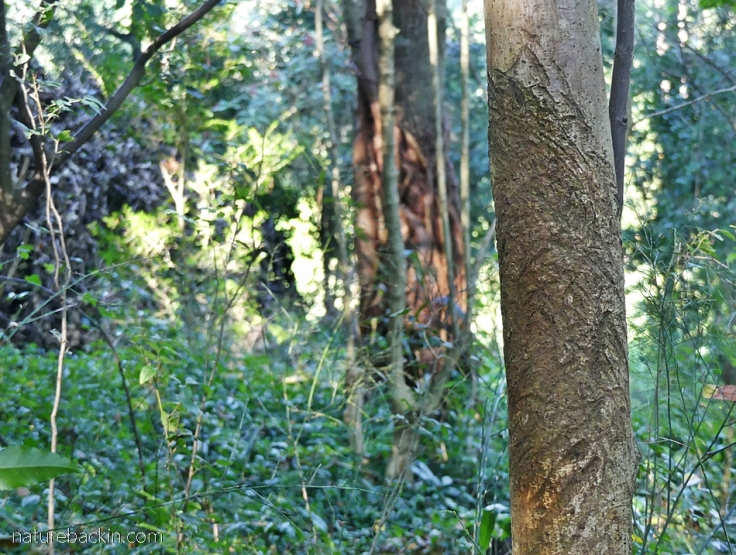
A tree on a path used by bushbuck just outside our fence, with its scarred bark showing that it is regularly used as a scratching post and a place for rams to sharpen their horns and possibly also for scent-marking
Usually we only catch glimpses of a bushbuck walking past our fence as they tend to move away if they know they are being observed. However, last month when I quietly went down to the back fence to see if I could get a photo of the black sparrowhawks that were calling from their nesting tree, instead I had an encounter with a young bushbuck ram who remained calm and curious, so long as I remained as still as possible when he lifted his head from browsing to look towards me.

It was hard to photograph the young bushbuck ram without alarming him, and also because of the intervening vegetation and the strong contrasts of brightness and shadow in the early morning light, but this photograph conveys something of the atmosphere of wary curiosity
Lately we have set up a trail camera behind our house. Before the plantation with its thirsty trees was established a few decades back, a stream used to run in the small valley between us and the plantation. Now because of the plantation, the stream is continually dry. We have placed a small water trough outside our fence that we keep topped up by using a hose to supply water to the birds and wildlife that manage to eke out an existence on the urban edge, despite the many threats they face, including from hunting by domestic dogs and cats, traps and snares placed by poachers, and hunters using packs of dogs to flush out prey.
Our water trough receives regular visitors – mostly birds and porcupines, and occasionally also genets. Sadly the bushpigs that were here as recently as five years ago are no more. Antelope that hang out in the area are the common duiker, the blue duiker and bushbuck. Although we have not seen any of the antelope utilising the water trough they are regularly seen passing by or browsing along the pathways.
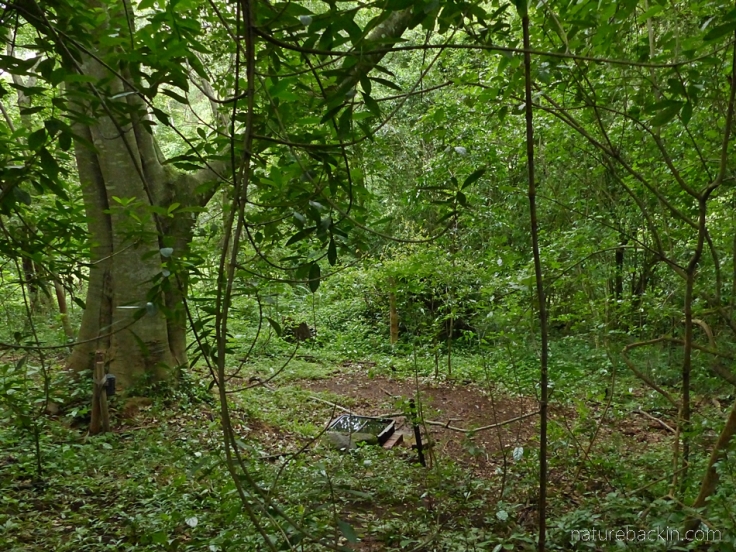
Here is a collation of recent video clips from the trail camera featuring bushbucks passing by and browsing. To our delight one of the clips features a very young calf.
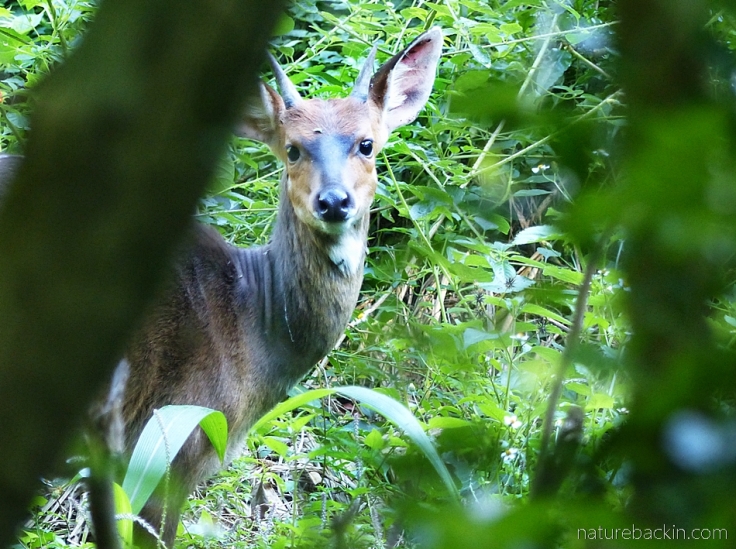
The young ram stopped to give me a rather penetrating stare before resuming browsing and despite the fact that the vervet monkeys that were also visiting were very perturbed by my unusual behaviour as I skulked in the bushes as I observed the bushbuck
Sources:
Dorst, Jean & Dandelot, Pierre. 1984. A Field Guide to the Larger Mammals of Africa. London: Collins; Emmett, Megan. 2020. Bushbuck. https://www.awf.org/wildlife-conservation/bushbuck; Estes, Richard. 1993. The Safari Companion a Guide to Watching African Mammals. Halfway House: Russel Friedman.
Posted by Carol






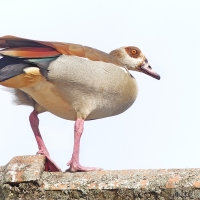
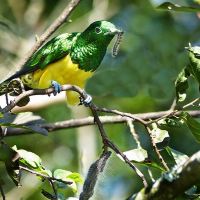
July 9, 2020 at 1:56 am
Again so lovely Carol! I love the ‘jagged’ walk that seems to be a common trait of bushbuck!
xxx
LikeLiked by 1 person
July 9, 2020 at 8:28 pm
‘Jagged’ is an interesting way of describing their walk!
LikeLike
July 2, 2020 at 9:56 am
I so enjoyed this blog and revisiting that lovely area and its inhabitants. Happy times.
LikeLiked by 1 person
July 2, 2020 at 9:02 pm
Thanks Christine. They were indeed happy times xxx
LikeLike
June 30, 2020 at 3:24 am
I truly enjoyed the video. Your bushbucks are a bit similar to our local deer. Ours can definitely wreak havoc in a garden, but they are far more habituated to humans. Besides yours seem downright dainty compared to ours crashing through the brush. I see in an above comment that they’re considered to be antelope. I’m not sure we even have any antelope here except for the pronghorn antelope (which aren’t considered to be true antelopes, though I can’t recall why that was the case.)
LikeLike
June 28, 2020 at 3:36 pm
I spotted a large Bushbuck near our back fence this evening. We both stoped and watched each other for some time. Eventually after I had moved back towards the garage it barked and dissapeared. I thought it strange for it to bark.
John
LikeLiked by 1 person
June 28, 2020 at 7:16 pm
It is likely the same big chap we see. How nice to stop and watch each other like that. It is surprising it barked as you moved away. We heard a loud bark three mornings ago but did not see the buck.
LikeLike
June 27, 2020 at 7:43 pm
How lovely! I enjoyed watching bushbucks when I was on safari, years ago, but didn’t know that they were garden visitors in some areas. Nice trailcam footage and the dove is pretty too.
LikeLiked by 1 person
June 28, 2020 at 7:13 pm
Thanks Adele. It is surprising that some antelope including bushbuck have adapted to the urban edges. The doves did add a nice dimension to the clips ☺
LikeLiked by 1 person
June 27, 2020 at 8:56 am
Beautiful. The video clip is especially soothing. Very recently I moved to our bedroom window (ground floor) to close the curtains and came face to face with an adult deer. We watched each other for some while. I knew I would lose the moment if I tried to get a camera so I simply enjoyed it for what it was – the privilege of exchanging glances with such a beautiful and delicate creature.
LikeLiked by 2 people
June 28, 2020 at 7:05 pm
How lovely to connect with a deer like that. Having a camera would have prevented such a special and memorable encounter.
LikeLiked by 1 person
June 27, 2020 at 5:34 am
Wonderful post Aunty Carol.
Love the video. That baby is tooo sweeeeeet! ❤️
Thank you for sharing nature with us, even in this time where getting out into nature and game parks has been off the table.
Looking forward to your next post.
Much love 💕
LikeLiked by 1 person
June 28, 2020 at 6:59 pm
Thanks so much Debs. I so agree about that baby 😊 it is incredible how much wildlife finds a way to survive so close to urban areas, seemingly against the odds. It will be good to visit nature parks again when the time is right.
Take care and love to you all
LikeLike
June 27, 2020 at 5:26 am
That is lovely, such gentle sweet creatures. What a treat to be able to see them from your fence! Such a good idea to put water out Carol well done. Loved the video footage.
LikeLiked by 1 person
June 28, 2020 at 6:54 pm
Thank you Carol. It is a treat to see them so close by and good to know you liked the video clips.
LikeLike
June 26, 2020 at 10:45 am
Nice Post Carol. Loved it!
LikeLiked by 1 person
June 26, 2020 at 8:23 pm
Thanks so much Suzette. Bushbuck are such beauties and we are lucky to have them around even though we seldom see them.
LikeLike
June 26, 2020 at 9:46 am
They are such gentle, elegant creatures. Thank you for sharing your patient, beautiful photographs and enchanting video. I commend you for your care and ingenuity
LikeLiked by 1 person
June 26, 2020 at 8:21 pm
Thanks Mariss. They are indeed lovely creatures. I am glad you like the video that I managed to craft out of the short clips from the trail camera. I was sorry there was not a clip of the baby in the same frame as its mother. It was a nice surprise though to find it on camera.
LikeLike
June 26, 2020 at 9:25 am
Lovely photos and observations as usual. We too recently acquired a trail camera, but we haven’t had much luck getting it to spot the foxes and badgers we know are here. A heron fishing has been our success story. And we’ve seen more deer round and about during lockdown.
LikeLiked by 1 person
June 26, 2020 at 8:14 pm
Thanks Margaret. I wonder why you have not had much luck getting footage of foxes and badgers – I suppose it helps to know where dens are and also the paths they regularly take otherwise it would involve random luck to get them on camera? Are the deer gaining confidence during the quieter times, although I suppose the quieter times will disappear if the lockdown continues to ease?
LikeLiked by 1 person
June 27, 2020 at 7:05 am
They’re already disappearing – the quiet ties that is. I have to think where to put my camera. The best places would be at the edge of the private grounds, where it would be visible from the path. The local nature reserve is always having its trail cameras stolen …. 😦
LikeLiked by 1 person
June 27, 2020 at 7:34 pm
Hi Margaret, I use trailcams for foxes and badgers (notwithstanding an unfortunate recent incident where badger cubs chewed a cam off the tree and ran off with it!)
I know it is often difficult to find a good spot which is safe from people, but as you probably know, if you have the opportunity to look along a wall or fence and find a place where they have dug under it, that’s usually a good bet. I usually put them about 40cm above the ground, i.e. fox eye height.
LikeLiked by 2 people
June 28, 2020 at 8:11 am
Thanks for the hints. I’ll persist even at the risk of my hoped-for subjects chewing it to bits!
LikeLiked by 1 person
June 28, 2020 at 7:02 pm
Quite sad in a way that the quiet times are disappearing. Too bad about trail cameras being stolen. I was going to mention how Adele had a camera taken by badgers but I see she has already been in touch.
LikeLiked by 1 person
June 29, 2020 at 7:50 am
Traffic is if anything worse as people shun public transport. I’ve been guilty of this myself. Aaagh. And if badgers are taking to property theft, there really is no hope.
LikeLiked by 1 person
June 29, 2020 at 2:28 pm
It is understandable to avoid public transport.
Hopefully the badgers might relinquish the cameras when they next do a bit of housekeeping!
LikeLiked by 1 person
June 29, 2020 at 3:01 pm
Dream on!
LikeLiked by 1 person
June 26, 2020 at 6:57 am
What a delight to be able to see these pretty animals from your garden! It set me thinking about the Bushbuck that hang around the fringes of picnic areas in the KNP. I wonder if this period of lock-down is weaning them away from the handouts they get despite notices asking visitors not to feed them.
LikeLiked by 1 person
June 26, 2020 at 8:11 pm
We are fortunate to have these lovely antelope about. I have also wondered how habituated animals at picnic sites and the like are adapting without the visitors who fed them. I think they might be having a healthier diet even if food will be harder to find. It must also have an effect on their social system and even social density as they might start dispersing away from the picnic areas etc.
LikeLiked by 1 person
June 26, 2020 at 5:08 am
I like your photos of the wary bushbacks, and the video too. How fun to have set up a trail camera. It’s interesting how some animals seem able to adapt to human encroachment, where for others it’s a death knell.
LikeLiked by 1 person
June 26, 2020 at 8:07 pm
Thanks Graham. Yes the trail camera is interesting although the quality of the night-time shots is not great.
It is amazing how some animals, even quite large ones, are adaptable enough to survive even in adverse circumstances in human-dominated landscapes. Bushbucks have an advantage in that they can be more or less solitary, can adapt to being almost entirely nocturnal, and can be fairly adaptable concerning what they eat. Being wary and reclusive must help too and also that in many regions breeding is not tied to the seasons.
LikeLiked by 1 person
June 27, 2020 at 3:25 am
I’ve been quite enjoying the photos of animals revisiting cities and other ‘human’ areas during lockdowns. I expect they’ll be avoiding those places again in a hurry.
LikeLiked by 1 person
June 28, 2020 at 6:51 pm
I expect so too …
LikeLiked by 1 person
June 26, 2020 at 2:55 am
Our own Bambi! Especially cute little lambs like the one in your video.
Amazing to think that an antelope as large as a bushbuck can persist in such urbanized settings, with all the dangers you’ve mentioned. A few years ago a solitary ram was found here in the Moreletakloof, amazingly several decades after the suburb of the same name was built and covered the entire surrounding area. Whether he was born there or moved there (how would that even have been possible?) no one seemed to know, but a few females were brought in to keep him company and now there’s a thriving population again in that little pocket of eden just a stone’s throw from our home.
LikeLiked by 1 person
June 26, 2020 at 8:02 pm
Yes that little baby – I never know whether they are mostly called lambs or calves – is a real Bambi.
How interesting that the ram you mention was able to survive in such a built-up area, and good news that he thrives now with the females brought in to keep him company. How remarkable and good news too.
LikeLiked by 1 person
June 26, 2020 at 1:04 am
Graceful creatures, they are smaller than I expected. Great captures, Carol. I loved seeing the video clips, esp. the wee one. 🙂
LikeLiked by 1 person
June 26, 2020 at 7:59 pm
They are I suppose medium-sized buck, and although graceful they have a relatively chunky build for an antelope, particularly the rams. I am glad you enjoyed the video clips and the baby was an unexpected delight.
LikeLiked by 1 person